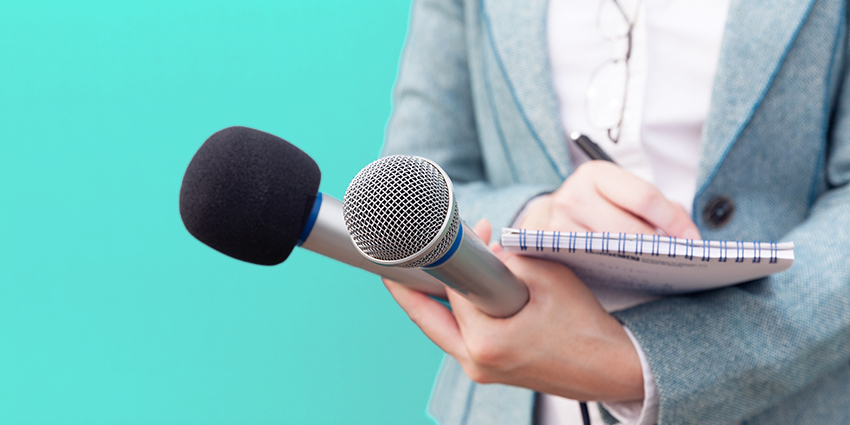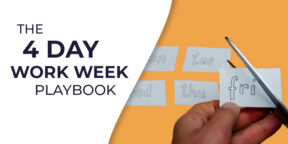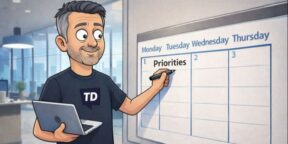B2B journalism is still essential, particularly for companies that want to go beyond “owned media” with relevant, engaging content that snags the trust of complex buyer committees. Interviews are a big part of the journalist’s toolkit. They can be the ultimate way to convey genuine, authentic messages from brands that have something worth saying.
The problem? Most interviews in tech media are painfully forgettable. Even with multimedia journalism now giving us all countless new avenues to explore, a lot of publications still churn out the same stuff. The same jargon, same questions, same lifeless delivery.
It’s no wonder a lot of those interviews don’t actually deliver any real results. Think about it. In the B2B market, in particular, your audience has already seen it all – deepfakes, AI auto-blogs, fast-paced TikTok Q&As with data scientists. The standard recorded Zoom chat with a VP and a handful of vague quotes isn’t going to move the needle.
Being a multimedia journalist today means operating like a producer, editor, strategist, and brand builder, all in one take. You need strong interview strategies, sharper research, and content that can stretch across formats: video, audio, carousel, email, even AI-sliced microcontent.
So here’s your playbook, for multimedia interviews with impact.
Research and Prep: The Foundations of Multimedia Journalism
Interviews aren’t everyday conversations. They’re explorations – deep dives into specific ideas, topics, or pain points. If you don’t have a map for where you’re going to direct the conversation, you’re going to end up with 20 minutes of vague chatter.
Planning is one of the most important steps in our content creation process here at Today Digital, whether we’re writing articles, producing opinion pieces, or conducting interviews.
Start with identifying your audience, and be specific. Who’s going to watch this video in your company’s buyer committee? An engineer, CFO, partner, founder, or someone else entirely? Every person has a specific focus.
CIOs care about deployment costs and scalability. Product managers care about user behavior and integration headaches. If you frame every interview as if the audience is “just curious,” you’ll end up with fluff. Every question you write should answer: what’s the takeaway for someone trying to make a decision? Once you’ve got your audience:
Use the Tools that Actually Help
Your CRM platform is great for deep-dive insights into your audience, but there are plenty of other tools out there that can help you find relevant topics, and questions to ask in a multimedia interview. You might use:
- Bombora to track real buying interest.
- Google Trends for signals and timing windows.
- ChatGPT and similar tools for framing, comparisons, and jargon translation.
- LinkedIn and earnings calls for speaker intelligence.
You could even experiment with AI transcription tools that help you identify relevant topics mentioned in previous discussions with the person or people you’ll be interviewing.
Map the Business Impact Before You Ask
The method: trace the line from “problem to solution to outcome” before the call. If that map doesn’t exist, the interview likely won’t go anywhere useful. This is lifted straight from our interviewing tips workshop, and it works every time.
Ask:
- What was broken?
- Who felt it?
- What changed?
You’ll avoid bland “how does it work” questions and get right into friction points, behavioral shifts, or missed expectations.
Understand the Market Context, Not Just the Company
No story happens in isolation. A CX automation tool launching in 2023 was a different story than one launching in Q2 2025, under budget constraints and AI policy scrutiny.
Being a strong multimedia journalist means you’ve done enough homework to connect the dots before the speaker does. Collect as much context as you can, it’ll lead to deeper, more valuable questions, and help you create more relevant, interesting content.
Multimedia Journalism: Designing Smart Questions
Interview questions can’t do all the work. But they do give you a specific path to follow, and help to prevent interview videos or articles from being filled with useless fluff.
At Today Digital, we recommend building something called a “question pyramid.” Instead of listing a bunch of disconnected questions like “What do you think about AI?” and “Who’s your target audience”, structure the conversation like a climb:
Start grounded: “What’s the business case?”
Then: “How did you design the rollout?”
Finally: “What’s the long-term risk if this doesn’t scale?”
Other ways to upgrade your interview strategies with effective questioning include:
Using Question Types That Create Tension
You don’t always want to make your interview subject feel like they’re being interrogated, but creating tension often leads to more impactful, engaging content. Try a few different question types to push the conversation further:
- Challenge questions: “What almost killed this before it launched?”
- Market risk questions: “Who’s betting against this working?”
- Vision questions: “What would need to be true for this to scale globally?”
If you’re worried about making someone uncomfortable during a video interview, you can always share some of those questions with them in advance.
Add the Experience Mapping Layer
Most journalists ask about products. Better ones ask about experience layers:
- How did support agents respond?
- What happened to onboarding time?
- Did NPS or churn shift?
You’re pulling the lens wider without losing depth. It’s a multimedia journalism power move, because it creates assets your marketing, sales, and editorial teams can all use differently.
Allow Room for Movement, Not Drift
Planning matters. But the best interviews have moments where the guest says something unscripted and raw, and you have to decide: is this useful, or is this noise?
Anchor questions help. So does segmenting the conversation clearly: intro context, decision insight, takeaway moment. But the real skill is knowing when to cut off a ramble or chase a tangent, without losing the rhythm. Think of it like editing in real time.
Multimedia Journalism: Hosting for Impact on Visual Channels
You’ve done the prep. You’ve got your interview questions ready. Now comes the part that most people underestimate: how you show up. With multimedia journalism you’re probably not just creating an article. You’re designing videos, clips, even podcast segments.
Your voice, appearance, and personality shapes how effective this content will be.
We’ve all seen boring interviews that don’t hit home because they feel like someone’s just reading nervously from a script. If you’re on camera, or your voice is being recorded, you need energy.
Multimedia journalism is performative in the best way. It’s about crafting moments that feel natural, even when they’re designed for distribution. Don’t over-rehearse things, script the first sentence if you need to, then be ready riff.
Other quick tips:
Think in Formats, Not Just Files
Good multimedia journalists don’t “record an interview.” They generate building blocks. Here’s how you might break it down:
- Hook clip (15–30s with a punchy soundbite).
- Insight clip (data point + reaction).
- Social tile quote (bold, confident claim).
- Email teaser (problem > promise > link).
Take your best intro lines and make them promo assets. Every interview should leave you with at least 3 reusable formats. If not, go back and trim the fat.
Audio-First Is Its Own Discipline
If you’re doing podcasts, treat them like design. Every pause, every transition, every vocal shrug, those are moments people hear and judge. Use pacing deliberately. Give ideas room to breathe. Ask short questions to get long answers.
Editing is your friend. Cut rambling, isolate the important quotes that might get buried, and respect your audience’s time. They’re already listening to you over a thousand other things.
Bring AI Into the Workflow
You probably shouldn’t be trusting AI to generate all of your questions or convert your entire interview into a fully-polished article. But it’s great for little things, like turning transcripts into snippets, social posts, summaries, and lead gen assets.
Once you’re done with the interview, drop your transcript into a tool you like and ask:
- “Give me 3 headlines from this.”
- “Pull all metrics mentioned.”
- “Summarize the guest’s POV in 60 words.”
Mastering Remote & Global Interviews
Nervous about handling multimedia journalism in an age of globalization? It’s not really as complicated as it seems. You don’t need a set to host a great interview, but you do need to approach the process like you’re producing a show.
- Don’t just schedule, curate: Time zones are the easy part. What matters more is setting the speaker up to succeed. That means asking for preferred talking points (not scripts), sharing the intended angle, and doing pre-calls if the guest isn’t media-trained. Schedule on their teams, and remember to prioritize flexibility.
- Watch the Cues: Remote interviews make it easy to miss friction. Delays, awkward pauses, and repetition are all cues. They’re signs your question landed wrong or that the guest is dodging something. Adjust and reframe. Or pause and say, “Let me ask that differently.”
- Master your Setup: Decent mic. Clean background. Stable connection. Eye-level camera. You don’t need a studio. But if you can’t take 10 minutes to sound and look credible, don’t expect to be treated like a pro.
Repurposing the Interview: A Multimedia Asset Stack
If you’re only publishing one long-form video or podcast from your interview, you’re missing out on an opportunity to make great content stretch further. One interview can give you dozens of valuable resources for your content calendar.
A smart interview playbook builds ecosystems.
Think in “Clippables”
You don’t wait until post-production to find shareable moments. You design for them.
Write questions that naturally lead to punchy, 30-second answers. Prompt strong statements. Ask for numbers, predictions, or lessons learned. Those are the moments that get clipped, shared, and replayed. One great moment used across six formats is better than an hour of polite filler.
Repurpose with Intention
The best multimedia journalism teams don’t just distribute content, they translate it across touchpoints, connecting with various members of the buyer committee. Think of who you can appeal to with repurposed elements like:
- LinkedIn carousels: Showcase trends or myths from the interview.
- Email snippets: Frame a problem and tease a bold quote.
- Blog posts: Pull in context, industry references, and internal links.
- Short-form videos: Use B-roll or slides over key voice segments.
Build on the Interview Later
A really great interview can reveal things – new insights or topics to discuss that emerge naturally within the moment. You can’t necessarily afford to let those conversations follow every tangent, but you can come back later, with a secondary interview, or another thought leadership piece.
Think about how you can build on that interview later, whether you’re just diving deeper into a key takeaway, or having an in-depth roundtable discussion with multiple thought leaders about the key topic you’ve identified.
Mastering Multimedia Journalism: The Interview Playbook
A few years ago, being a multimedia journalist meant toggling between a notepad and a podcast mic. Today, it means owning the entire content arc, from research, production, repurposing, performance, and trust-building, while keeping your editorial instincts sharp.
Here’s the quick recap:
- Prep with strategy, not just info dumps.
- Ask questions that challenge, clarify, and connect to outcomes.
- Host like you’re crafting an experience, not just conducting a Q&A.
- Repurpose with intention, scale with AI, and deliver value across touchpoints.
Bonus tip: protect your integrity, even when you’re deep in brand conversations. Need more advice on that front? Check out our guide to maintaining editorial standards in B2B tech journalism. Otherwise, get out there and start prepping for your next interview.











